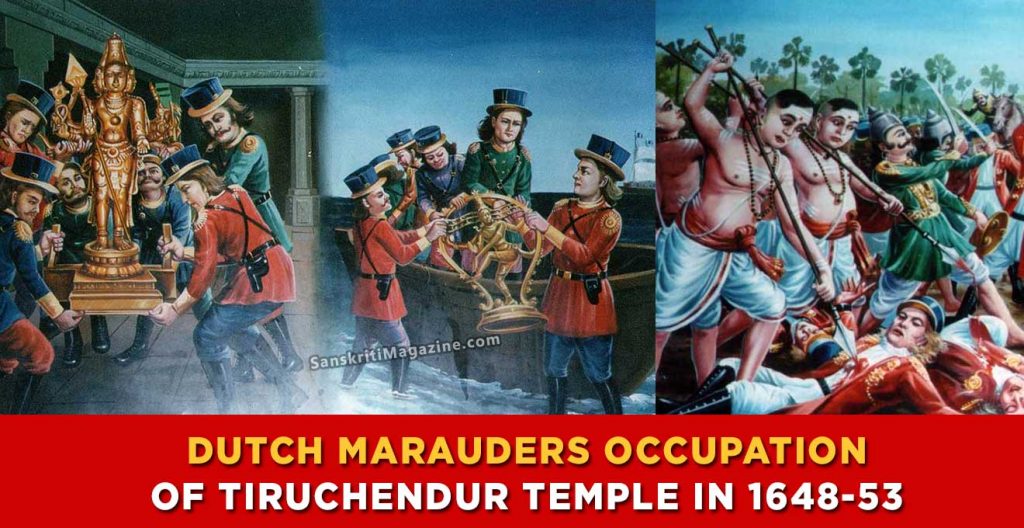The Murugan temple at Thiruchendur was occupied by the Dutch East India company between the years 1646 to 1648, during the course of their war with the Portuguese. The local people tried to free the temple for 2 years with several futile attempts. The Dutch finally were forced to vacated the temple on orders from the Naik ruler. However, while vacating the temple, they hacked away and removed the murtis (idols) of the main deity of the temple, and took it back to Galle, Dutch Ceylon. The murtis were returned after many negotiations with the Madurai Nayakar.
Thiruchendur Temple
The Thiruchendur Murugan Temple (properly known as Thiruchendur Arulmigu Senthilnathar Temple) located in the Tuticorin District, India, is considered to be one of the 6 abodes of the Tamil God Murugan the son of Shiva. No record exists on the data of actual construction of the temple, but there are records of improvements to the temple by Pandya and Chera Kingdoms. However, early Cankam poetry refer to the Murugan seashore shrine at Tirrucciralaivay, which is thought to refer to the Thiruchendur Temple. The earliest existing inscription at the temple is dated 875 AD, and talks about a Pantiyan called Varekuna Maran.
Dutch East India Company
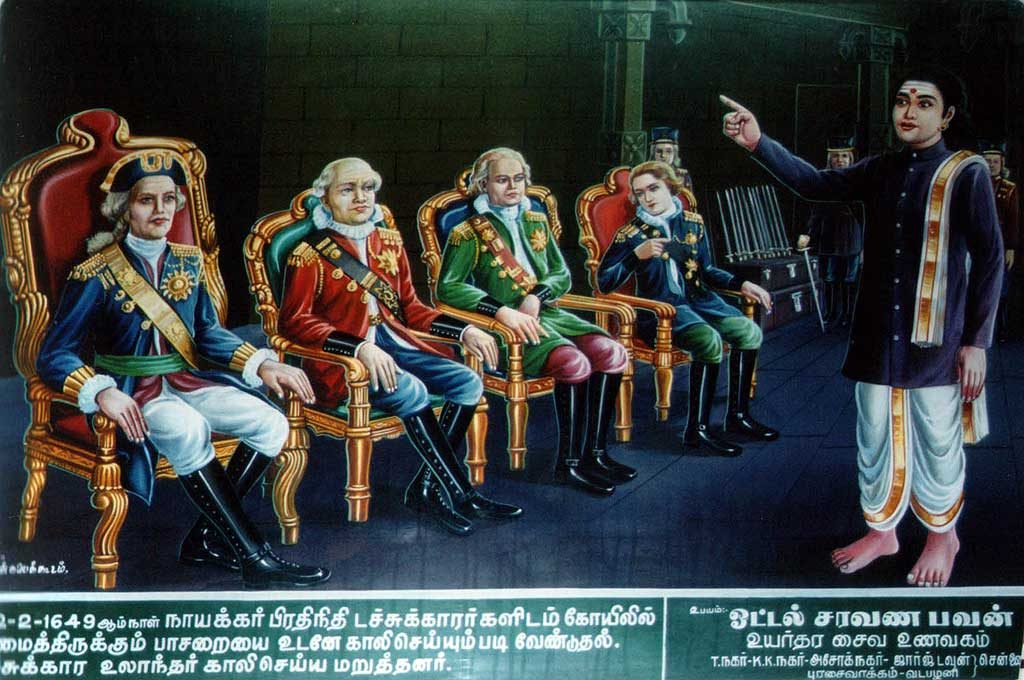
The Dutch sought the aid of their Governor at headquarters in Ceylon. He came over to the mainland in ten boats, landed at Manappar, seized the Portuguese Church at Virarampattanam, occupied the Temple at Tiruchendur and fortified the latter with guns.
The people were sorely distressed and they appealed to Tirumalai Nayak. The Nayak sent word to the Dutch to vacate the temple and re-imburse their loss at Kayalpattinam. The request was unheeded. The Dutch nevertheless marched on Tuticorin, ravaged the country all around it, and demanded 40,000 reals as a ransom to quit the place. The amount was also pressed for payment but only a small amount could be got together.
The Dutch established the Vereenigde ost-lndische Companies (VOC) or the Dutch East India Company was formed in 1602 in order to carry out trade with India. having established their control over Java, Sumatra, and the Spice Islands, India was necessary for maintaining their hold over the East Indies. Dutch factories were established at Agra, Ahmedabad, Balasore (1658), Baranagore, Bimlipatam (1641), Bombay, Broach, Burhanpur, Chinsura (1653) (Fort Gustavus), Cochin (1663), Karikal (1645), Kasimbazar and Patna. Throughout the 17th century, the Dutch established a monopoly over the spice trade.
Occupation of Thiruchendur Temple
In February 1649, The Dutch Governor of Ceylon, Joan Maetsuycker, led a force of 436 Europeans in an assault on the Portuguese. In the course of this conflict, the Dutch occupied the Portuguese possessions at Thiruchendur, Tuticorin and also the Murugan Temple. They fortified the temple, and used it as a garrison. The Gold and silver of the temple was freely looted by the soldiers. The local people made several futile attempts to gain control of the temple, and finally made a formal complaint to Thirumalai Nayak. Nayak mediated between the Dutch and the locals, advising the Dutch to vacate the temple, and also leave by the sea route, to prevent any further attacks on them.
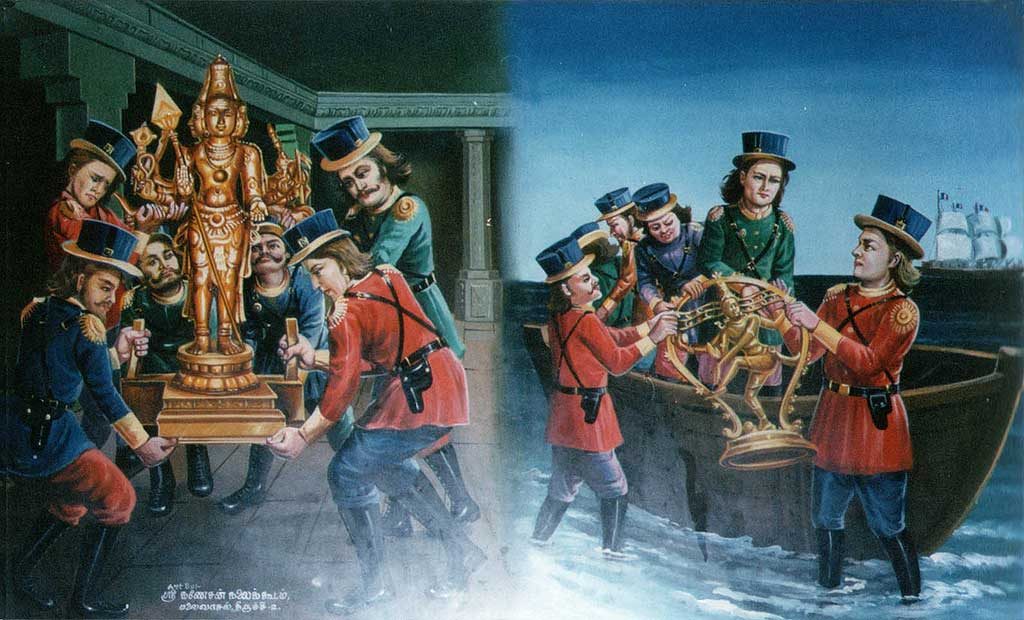
In 1648 the Dutch left Tiruchendur, taking with them all the temple icons, and demanding an enhanced ransom of 100,000 reals. They carried away the icons Shanmukhar and Siva Natarajar, thinking that they were made of gold
The Tiruchendur Temple was captured on 9 February 1649, and was used a base to launch attacks on the Portuguese interests of Tuticorin. The events are described by Dutch soldier Johann von der Behr of Leipzig (1620-1680) and Johan de Vogel (d.1674) who a junior merchant and secretary (p. 336).
While vacating the temple, the Dutch are said to have tried to destroy the structure by setting fire and bombardment. However their efforts were futile with the mandapams withstanding their battery attack. This is described by the French writer M Rennel, in his book A Description, Historical and Geographical, of India (1785), where the author claims he has heard the story from a former Dutch soldier who took part in the events.
Local legends
According to local tradition, while vacating the Tiruchendur temple, the Dutch decided to carry away the murti of the main deity of Shanmukhar and Śiva Natarajar, as they thought they were made of gold. Initial attempts to melt the murtis for the metal proved futile, and they carried away the murtis by sea. However, once at sea, there was a wild storm and the vessel shook violently. Frightened that the murtis had caused the bad weather, the Dutch sailors threw away the murti at sea.
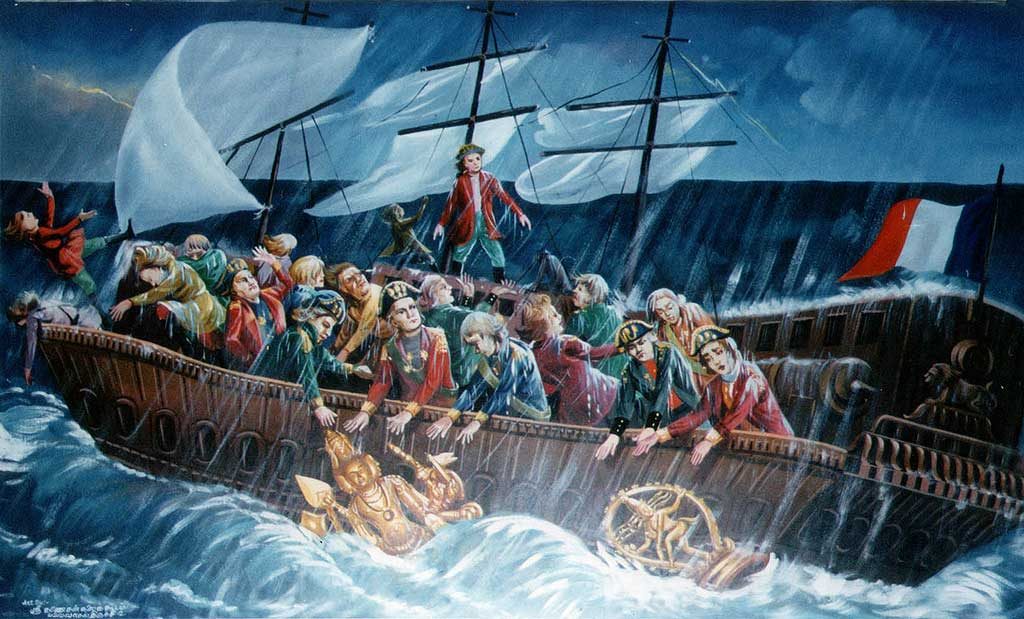
Meanwhile, the loss of the idmurtil was reported by the locals to Vadamalaiyappa Pillaiyyan, the local governor of Tirunelveli for the Madurai Naikaar. Following which, Pillaiyyan ordered for a new murti to be made, and this was made and transported to Tiruchendur.
Vadamalaiappa Pillaiyyan is said to have recovered the original murti from the sea, either by negotiating with the Dutch, (who had fled to Ceylon), or miraculously recovering it from the sea. According to local tradition, a dream revealed that the location where the murti was immersed would be shown by a floating lime, and a kite would be circling the skies. The place was supposed to have been found, and the murtis recovered by divers. The original murtis were installed back at the temple, and the replacement murti was installed at Tiruppirantîsvarar Temple (Venku Patcha Kovil) at Palamcottah
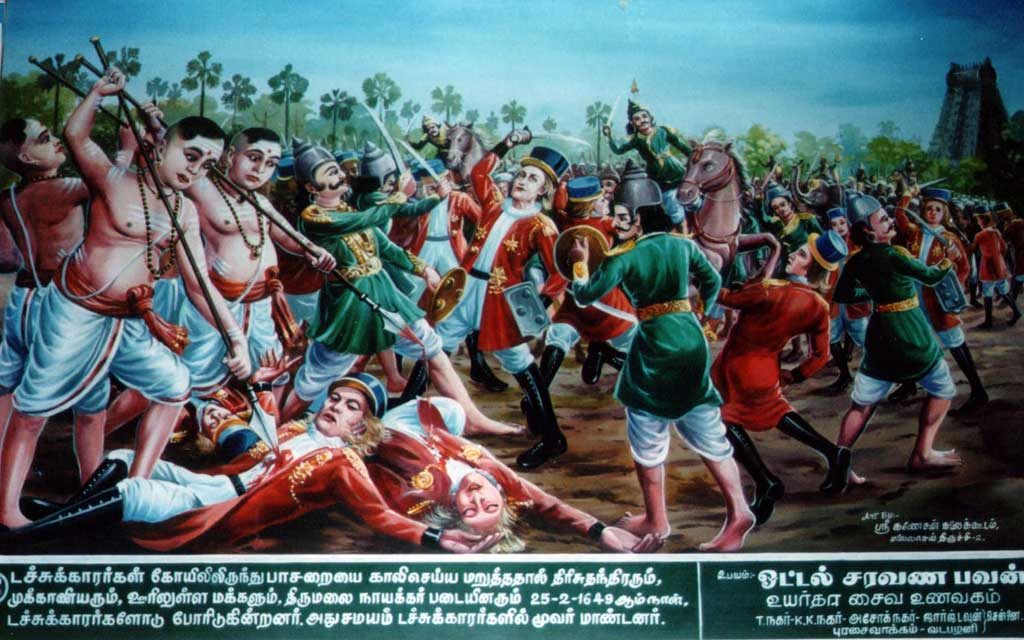
In the meanwhile the people at Tiruchendur gathered a force consisting of four elephants, 50 to 60 horses, and 500 to 600 men to oust the Dutch out of the temple. The attempt was unsuccessful with the loss of 50 men of the Nayak forces. The people were utterly helpless and sorely tried
Murti (idol) Recovery
The loss of the deities was discovered and duly communicated to Vadamalaiyappa Pillaiyyan, the local administrator of the Nayakkan ruler at Tirunelveli. A great devotee that he was, Pillaiyyan was sorely affected and knew not what to do. He ordered for a similar deity to be made in panchaloka. As the duplicate one was ready, and was on its way to Tiruchendur to be installed, in 1653 Vadamalaiappa Pillaiyyan had a dream.
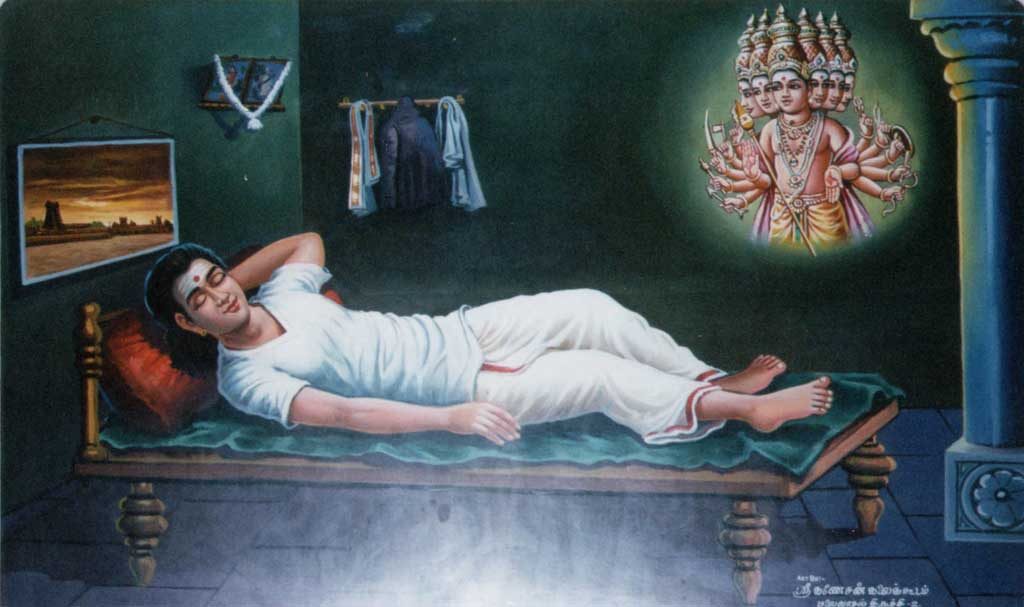
Acting to the advice conveyed to him by the God, he put out to sea and following the instructions that the deity was to be found at the spot whereon a lime fruit would be found floating, and the place marked by the circling overhead of a kite, the bird of Vishnu.
Vadamalaiappa Pillaiyyan recovered the original deity and reinstalled it in the temple in the year 1653. The replacement deity was then consecrated in the shrine of Tiruppirantîsvarar alias Venku Patcha Kovil situated east of Palamcottah (known as Murugan Kurichi).
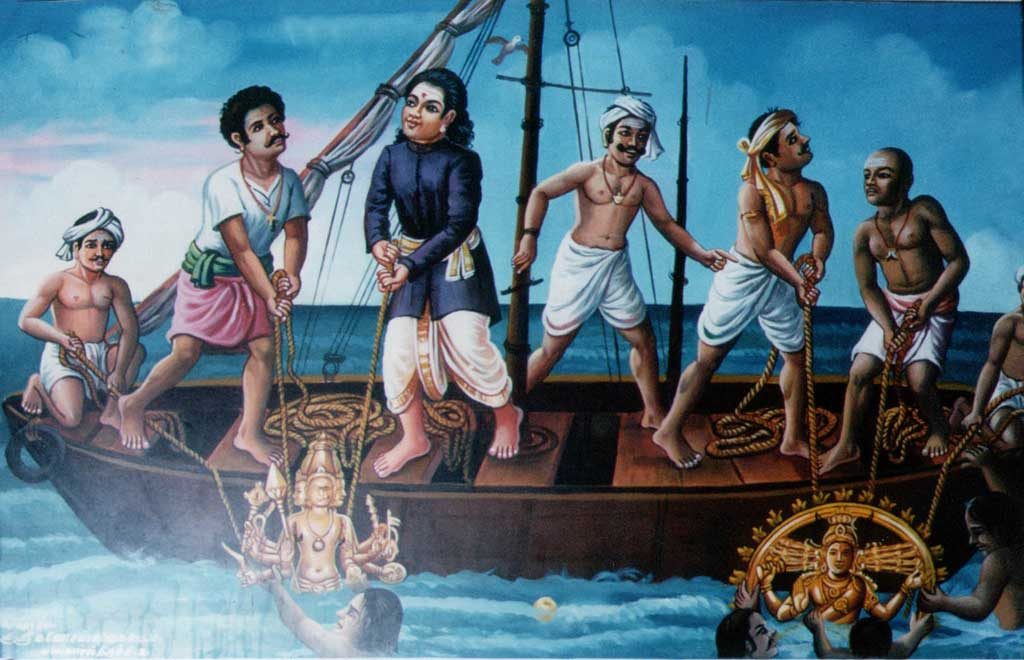
Vadamalaiappa was greatly struck by the Lord’s grace in giving him this great relief, in memory of which he erected a mantapa at Tiruchendur in his name and endowed it largely for the performance of a Kattalai abhishekam and pujas for Subrahmaniam on the seventh days of Masi and Avani festivals. An inscription at the mantapa relates the incidents referred to.
Among many others, kirtanas composed by Venri Malaik Kavirayar, are sung at this mantapa at the time when Shanmukhar is brought here for Ubaya Mandagappadi on the seventh day of the Masi and Avani festivals. The poem relates the incidents and their rejoicings at the Lord being got back again. “Vadamalai Venba” is another poetic panegyric on Vadamalaiappa Pillaiyyan.
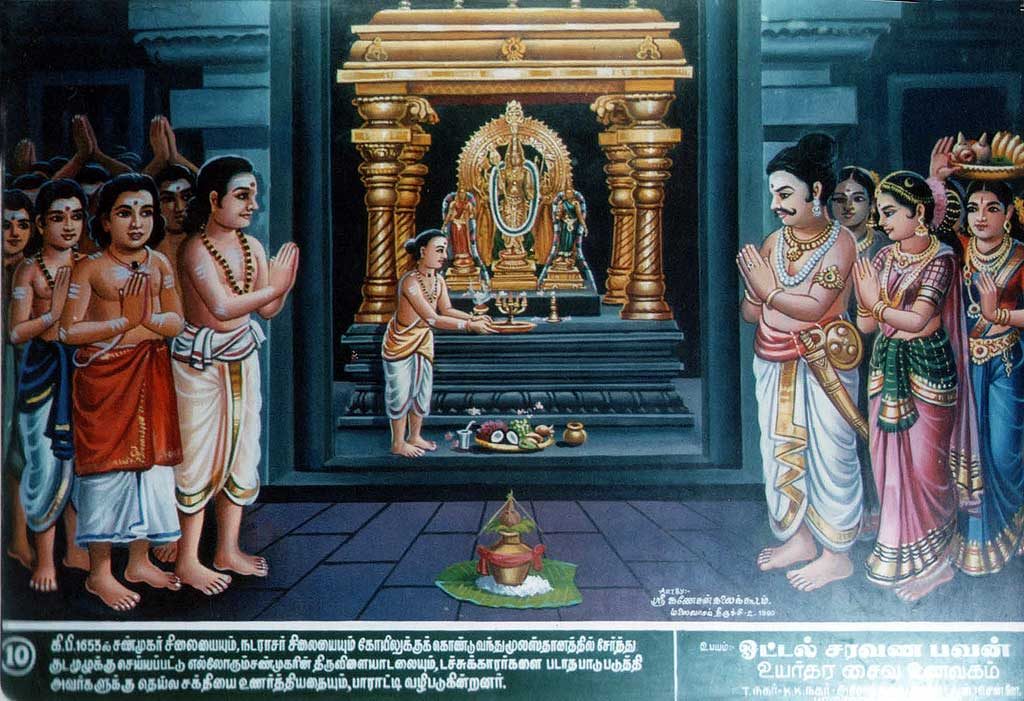
Vadamalaiappa Pillai reinstalled the original icon in the temple in the year 1653. The replacement icon was then consecrated in the shrine of Tiruppirantîsvarar alias Venku Patcha Kovil situated east of Palamcottah (known as Murugan Kurichi).
Vadamalaiappa Pillai was greatly struck by the Lord’s grace in giving him this great relief, in memory of which he erected a mantapa near Thoondikai Vinayakar Kovil at Tiruchendur in his name and endowed it largely for the performance of a Kattalai for Subrahmaniam on the seventh days of Masi and Avani festivals. An inscription at the mantapa relates the incidents referred to.
M. Rennel, the French author of A Description, Historical and Geographical, of India (published in Berlin, 1785), gives a picture of the temple, which, he says, he got from a soldier in the service of the Dutch Company. He relates an incident which offers a reasonable explanation of the Tiruchendur tradition. “In a descent made by the Dutch off the Coast in 1648,” he says, “the Dutch halted in the temple and on leaving did their best to destroy it by fire and by a heavy bombardment. But they only partially succeeded and the tower defied all their efforts.” Possibly the capture of the deity was one of their achievements.
As a matter of fact M. Rennel calls the place Tutucutin, but from the picture and an accompanying sketch-map it is clear that Tiruchendur was meant. The Dutch were incessantly at war with the Portuguese on the coast.

